10-i18n篇
前言
uniapp 的需要做国际化部分,大概有下面 4 部分
TempalteScript- 原生模块
UI库
Tempalte
uniapp 上国际化涉及到很多东西,还是涉及到原生模块的国际化,后续还需要进行封装所以,就没必要使用 vue-i18n 等插件了
我们完成可以自定义一个插件来实现国际化,代码体积也会小一点
我们以两个语言作为国际化(英文 & 中文),后期可以根据需要自己进行扩展即可
先建立 src/locale 文件,用于存放国际化的文字,en.json、zh-Hans.json
// src/locale/en.json
{
"pages.i18nDemo.index": {
"title": "i18n Multilingual Demo",
"authorText": "Author: DaMaiCoding",
"about": "A 'super super super' easy to use uniapp template",
"nowLocale": "Click to switch language(English-US)",
"calendarLabel": "Calendar"
}
}// src/locale/zh.json
{
"pages.i18nDemo.index": {
"title": "i18n 多语言 Demo",
"authorText": "作者:大麦大麦",
"about": "一个 “超超超” 好用的 uniapp 模板",
"nowLocale": "点击切换语言(简体中文)",
"calendarLabel": "日历"
}
}关于 pages.i18nDemo.index 这个 key 是用于区分是哪个页面的数据
【注意】文件名的命名有规范的,locale/语言地区代码.json,如:en.json,zh-Hans.json,zh-Hant.json
具体可以看下 uniapp 国际化部分
首先,要使用 pnina 创建一个来记录我们当前的选择的语言的变量
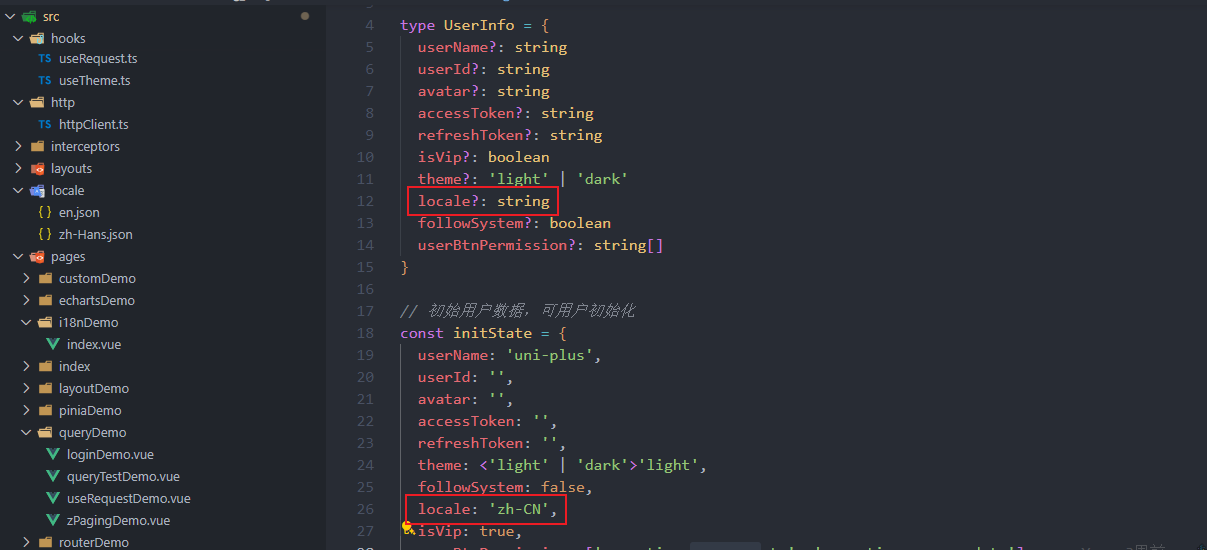
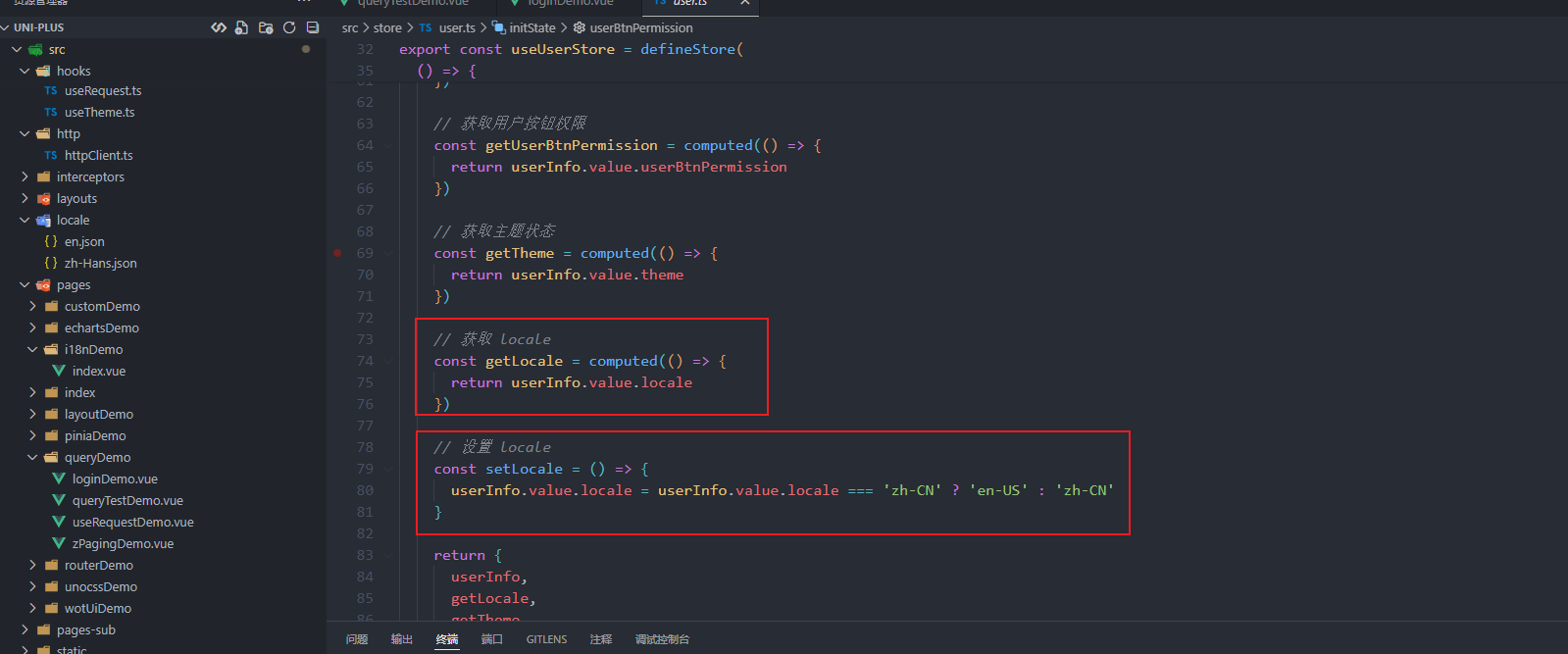
并且我们创建了两个函数 getLocale、setLocale 用于获取与设置当前语言(locale)
接下来,我们模仿 vue-i18n 的写法,创建一个 hooks 返回 t 函数来解析当前语言所对应的文字
其实原理非常简单,就是判断当前语言是 en-US 还是 zh-CN,然后使用 t 传过来的 key 读取对应 json 中的数据
getCurrentPages() 用于获取当前页面栈的实例,以数组形式按栈的顺序给出,比如:['pages/index/index', 'pages/i18nDemo/index']
最后把 / 替换为 . 就可以访问了
你可能要问了,为要用
.用/作为key不就好了,都不用转换了确实是这样,这样写主要是这样会看起来更符合
.语法获取数据,当然你也可以直接换成/
// src/hooks/useI18n.ts
import { useUserStore } from '@/store'
const store = useUserStore()
import en from '@/locale/en.json'
import zh from '@/locale/zh-Hans.json'
export const useI18n = () => {
const pagePath = getCurrentPages()
const pagePathKey = pagePath[pagePath.length - 1].route.replace(/\//g, '.')
const t = (key) => {
return (store.getLocale === 'zh-CN' ? zh[pagePathKey][key] : en[pagePathKey][key]) ?? ''
}
const setLocale = () => {
return store.setLocale()
}
return {
t,
setLocale
}
}<!-- src/pages/i18nDemo.vue -->
<template>
<button @click="setLocale">{{ t('nowLocale') }}</button>
<!-- 底部作者信息 -->
<div class="w-60% mt-10rpx opacity-60 m-auto">
<wd-divider>{{ t('authorText') }}</wd-divider>
</div>
</template>
<script setup lang="ts">
import { useI18n } from '@/hooks/useI18n'
const { t, setLocale } = useI18n()
</script>执行一下,我们到编译器中看下效果
pnpm dev:mp-weixin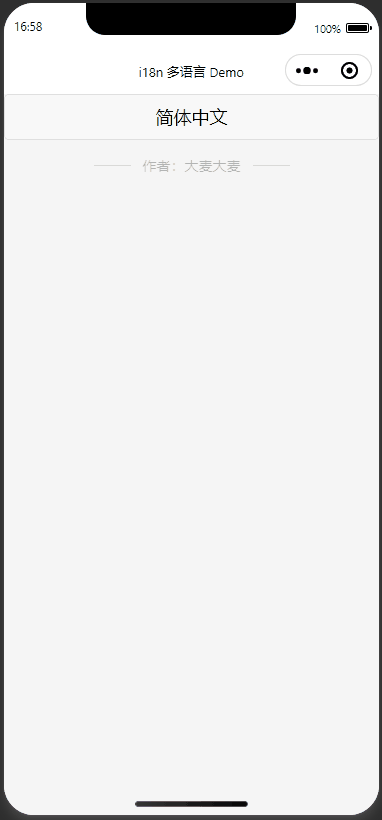
Script
上面那个是在 tempalte 中的国际化
那我们写在 script 中的数据能国际化吗?
<!-- src/pages/i18nDemo.vue -->
<template>
<button @click="setLocale">{{ t('nowLocale') }}</button>
<!-- 底部作者信息 -->
<div class="w-60% mt-10rpx opacity-60 m-auto">
<wd-divider>{{ t('authorText') }}</wd-divider>
</div>
<div class="w-100vw mt-10rpx opacity-60 flex justify-center font-size-28rpx" v-for="item in list" :key="item.about">
{{ item.about }}
</div>
</template>
<script setup lang="ts">
import { useI18n } from '@/hooks/useI18n'
const { t, setLocale } = useI18n()
const list = ref([
{
about: t('about')
}
])
</script>
可以看到,这并没有效果呀~
这是因为,ref 无法直接对 function 返回值进行监听
所以,为了让 t 函数返回值具有响应式,我们可以使用 computed 来加上响应式
传递参数,加一个 type 用于识别,是 template 中的数据,还是 script 中的数据
// src/hooks/useI18n.ts
import { useUserStore } from '@/store'
const store = useUserStore()
import en from '@/locale/en.json'
import zh from '@/locale/zh-Hans.json'
export const useI18n = () => {
const pagePath = getCurrentPages()
const pagePathKey = pagePath[pagePath.length - 1].route.replace(/\//g, '.')
/* 如果国际化是元素,直接返回,如果是 ref 中的数据就需要加 computed 不然不会动态变化 */
const t = (key, type?: string) => {
if (type === 'text') {
return computed(() => {
return (store.getLocale === 'zh-CN' ? zh[pagePathKey][key] : en[pagePathKey][key]) ?? ''
})
}
return (store.getLocale === 'zh-CN' ? zh[pagePathKey][key] : en[pagePathKey][key]) ?? ''
}
const setLocale = () => {
return store.setLocale()
}
return {
t,
setLocale
}
}<!-- src/pages/i18nDemo.vue -->
<template>
<button @click="setLocale">{{ t('nowLocale') }}</button>
<!-- 底部作者信息 -->
<div class="w-60% mt-10rpx opacity-60 m-auto">
<wd-divider>{{ t('authorText') }}</wd-divider>
</div>
<div class="w-100vw mt-10rpx opacity-60 flex justify-center font-size-28rpx" v-for="item in list" :key="item.about">
{{ item.about }}
</div>
</template>
<script setup lang="ts">
import { useI18n } from '@/hooks/useI18n'
const { t, setLocale } = useI18n()
const list = ref([
{
about: t('about', 'text')
}
])
</script>
原生模块
好啦接下来,就是要实现原生模块的国际化
比如,顶部导航栏,tabBar ...
这里我们先实现顶部导航栏,tabBar 也是同理,自己加一下即可
import { useUserStore } from '@/store'
import { Locale, useCurrentLang } from 'wot-design-uni'
import enUS from 'wot-design-uni/locale/lang/en-US'
import zhCN from 'wot-design-uni/locale/lang/zh-CN'
const store = useUserStore()
import en from '@/locale/en.json'
import zh from '@/locale/zh-Hans.json'
export const useI18n = () => {
const pagePath = getCurrentPages()
const pagePathKey = pagePath[pagePath.length - 1].route.replace(/\//g, '.')
const t = (key, type?: string) => {
/* 如果国际化是元素,直接返回,如果是 ref 中的数据就需要加 computed 不然不会动态变化 */
if (type === 'text') {
return computed(() => {
return (store.getLocale === 'zh-CN' ? zh[pagePathKey][key] : en[pagePathKey][key]) ?? ''
})
}
return (store.getLocale === 'zh-CN' ? zh[pagePathKey][key] : en[pagePathKey][key]) ?? ''
}
/* 切换 原生元素 语言 */
const changeNativeLang = () => {
// 切换 顶部导航栏 语言
uni.setNavigationBarTitle({
title: (store.getLocale === 'zh-CN' ? zh[pagePathKey]?.title : en[pagePathKey]?.title) ?? ''
})
// 切换 tabBar 语言
// ...
}
const setLocale = () => {
/* 切换 语言 */
store.setLocale()
changeNativeLang()
}
/* 页面初始化渲染一次 */
changeNativeLang()
return {
t,
setLocale
}
}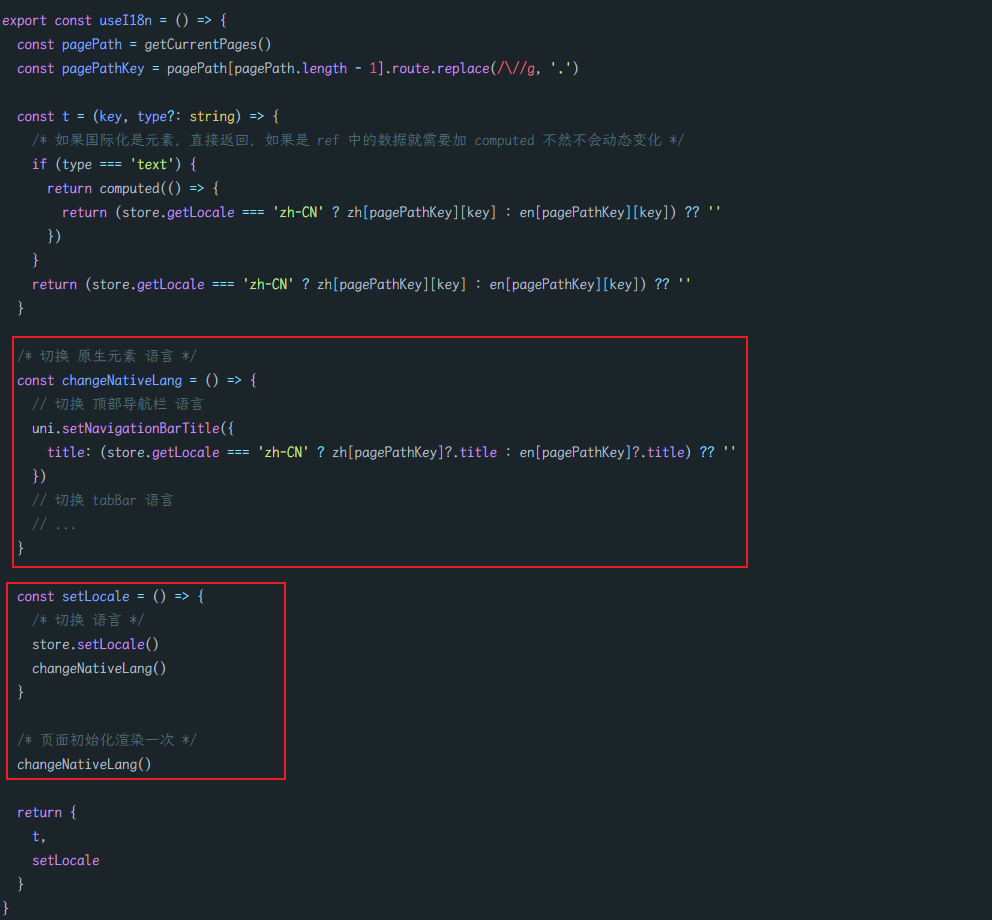
原生元素封装成一个函数 changeNativeLang
uni.setNavigationBarTitle 是用于切换 顶部导航栏 文字
我们需要进入页面就根据当前语言,渲染 顶部导航栏
hooks 被首次加载时,就会默认执行一次,那么我们在末尾执行一下 changeNativeLang(),就相当于进入页面渲染一次
在设置语言的时候,也切换执行一下 changeNativeLang
<route type="page" lang="json5">
{
style: {
navigationBarTitleText: '%pages.index.index.title%'
}
}
</route>
<template>
<button @click="setLocale">{{ t('nowLocale') }}</button>
<!-- 底部作者信息 -->
<div class="w-60% mt-10rpx opacity-60 m-auto">
<wd-divider>{{ t('authorText') }}</wd-divider>
</div>
<div class="w-100vw mt-10rpx opacity-60 flex justify-center font-size-28rpx" v-for="item in list" :key="item.about">
{{ item.about }}
</div>
</template>
<script setup lang="ts">
import { useI18n } from '@/hooks/useI18n'
const { t, setLocale } = useI18n()
const list = ref([
{
about: t('about', 'text')
}
])
</script>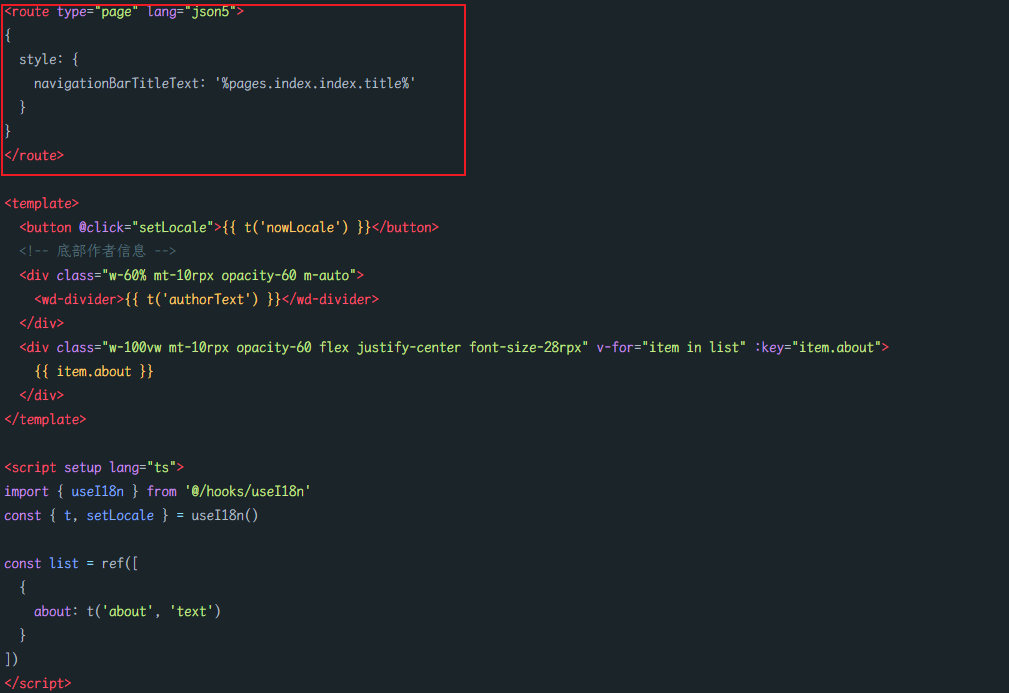
navigationBarTitleText: '%pages.index.index.title%',locale 目录下,语言地区代码.json 文件中定义的 key,使用 %% 占位
这里是使用 @uni-helper/vite-plugin-uni-layouts 的路由配置
如果不使用这个插件,可以直接在 src/pages.json 改对应路由配置也可以
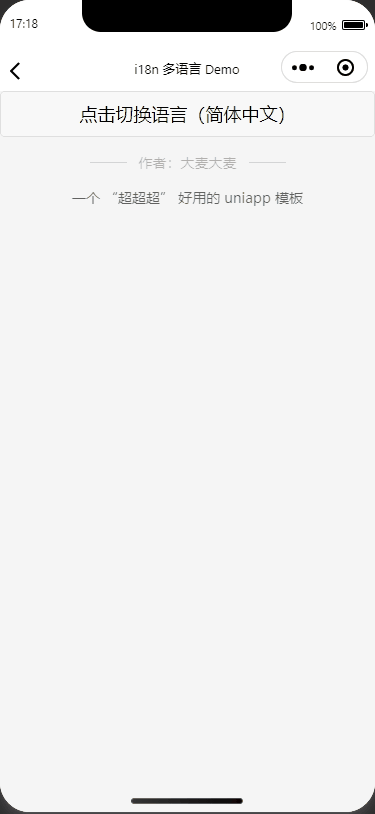
UI 库
组件库部分,需要根据组件库自己的切换方式来定,这里只介绍 Wot UI 的语言切换方式
import { Locale, useCurrentLang } from 'wot-design-uni'
import enUS from 'wot-design-uni/locale/lang/en-US'
import zhCN from 'wot-design-uni/locale/lang/zh-CN'先引入 Wot UI 的语言包
Locale 用于设置当前 Wot UI 组件的文字语言
useCurrentLang 用于获取当前语言
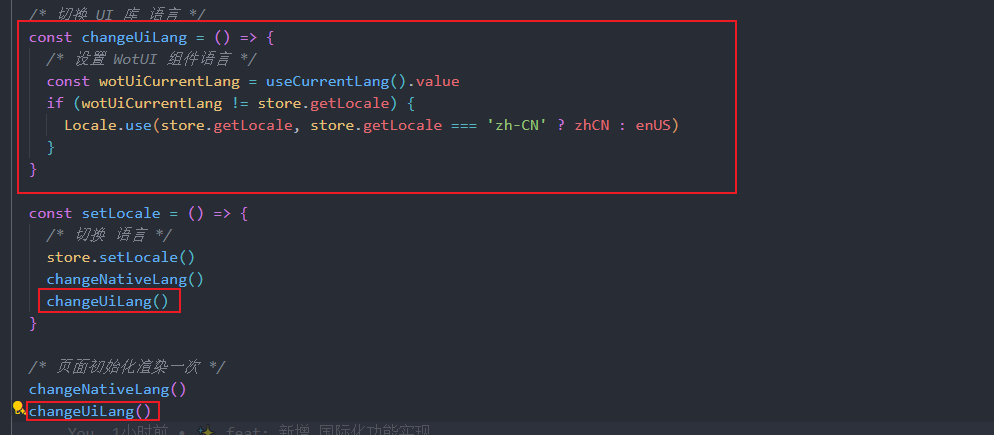
import { useUserStore } from '@/store'
import { Locale, useCurrentLang } from 'wot-design-uni'
import enUS from 'wot-design-uni/locale/lang/en-US'
import zhCN from 'wot-design-uni/locale/lang/zh-CN'
const store = useUserStore()
import en from '@/locale/en.json'
import zh from '@/locale/zh-Hans.json'
export const useI18n = () => {
const pagePath = getCurrentPages()
const pagePathKey = pagePath[pagePath.length - 1].route.replace(/\//g, '.')
const t = (key, type?: string) => {
/* 如果国际化是元素,直接返回,如果是 ref 中的数据就需要加 computed 不然不会动态变化 */
if (type === 'text') {
return computed(() => {
return (store.getLocale === 'zh-CN' ? zh[pagePathKey][key] : en[pagePathKey][key]) ?? ''
})
}
return (store.getLocale === 'zh-CN' ? zh[pagePathKey][key] : en[pagePathKey][key]) ?? ''
}
/* 切换 原生元素 语言 */
const changeNativeLang = () => {
// 切换 顶部导航栏 语言
uni.setNavigationBarTitle({
title: (store.getLocale === 'zh-CN' ? zh[pagePathKey]?.title : en[pagePathKey]?.title) ?? ''
})
// 切换 tabBar 语言
// ...
}
/* 切换 UI 库 语言 */
const changeUiLang = () => {
/* 设置 WotUI 组件语言 */
const wotUiCurrentLang = useCurrentLang().value
if (wotUiCurrentLang != store.getLocale) {
Locale.use(store.getLocale, store.getLocale === 'zh-CN' ? zhCN : enUS)
}
}
const setLocale = () => {
/* 切换 语言 */
store.setLocale()
changeNativeLang()
changeUiLang()
}
/* 页面初始化渲染一次 */
changeNativeLang()
changeUiLang()
return {
t,
setLocale
}
}与切换原生元素一样,设置一个切换函数,并且页面初始化的时执行一次,切换语言也调用一下

<route type="page" lang="json5">
{
layout: 'theme', // 使用主题
style: {
navigationBarTitleText: '%pages.index.index.title%'
}
}
</route>
<template>
<button @click="setLocale">{{ t('nowLocale') }}</button>
<!-- 底部作者信息 -->
<div class="w-60% mt-10rpx opacity-60 m-auto">
<wd-divider>{{ t('authorText') }}</wd-divider>
</div>
<div class="w-100vw mt-10rpx opacity-60 flex justify-center font-size-28rpx" v-for="item in list" :key="item.about">
{{ item.about }}
</div>
<div class="w-100vw mt-40rpx">
<wd-calendar v-model="calendarData" :label="t('calendarLabel')" />
</div>
</template>
<script setup lang="ts">
import { useI18n } from '@/hooks/useI18n'
const { t, setLocale } = useI18n()
const calendarData = ref<number>(Date.now())
const list = ref([
{
about: t('about', 'text')
}
])
</script>
<style>
/* 暗黑模式 start */
.wot-theme-dark {
color: #f5f5f5;
background: black;
--theme-bg-color: #1b1b1b;
}
</style>我们使用一个 日历日期选择组件(wd-calendar)来测试下
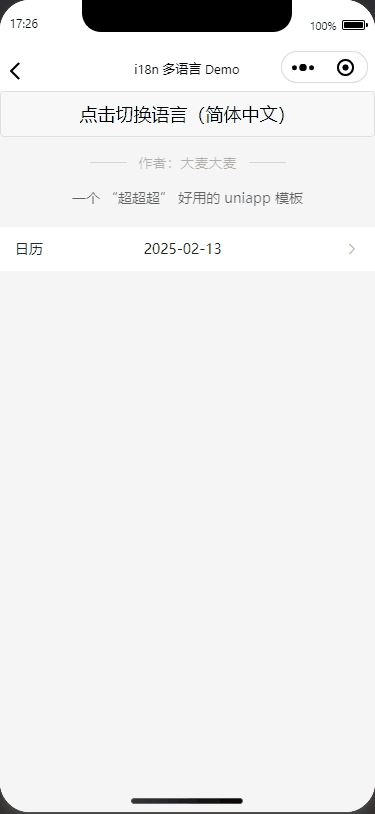
【注意】
目前组件库发布到 npm 上的包是未经编译的 vue 与 ts,而 Vite 会将预构建的依赖项缓存到 node_modules/.vite,组件库的国际化的实现是基于 reactive 实现的数据共享,在 dev 阶段就会出现页面使用预构建产物中的国际化数据,而组件库使用组件库内部的国际化数据,所以在非 uni_modules 模式引入时,需要在 vite.config.ts 中增加以下配置
import { defineConfig } from 'vite'
import uni from '@dcloudio/vite-plugin-uni'
export default defineConfig({
...
optimizeDeps: {
exclude: process.env.UNI_PLATFORM === 'h5' && process.env.NODE_ENV === 'development' ? ['wot-design-uni'] : []
}
...
})使用 optimizeDeps.exclude在预构建中强制排除 wot-design-uni 模块,在 uni_modules 模式下,不需要做任何处理。
